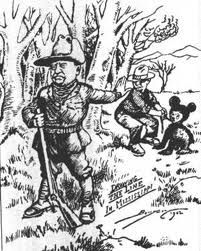Cross posted from The Stars Hollow Gazette
This is your morning Open Thread. Pour your favorite beverage and review the past and comment on the future.
Find the past “On This Day in History” here.
February 23 is the 54th day of the year in the Gregorian calendar. There are 311 days remaining until the end of the year (312 in leap years).
On this day in 1954, a group of children from Arsenal Elementary School in Pittsburgh, Pennsylvania, receive the first injections of the new polio vaccine developed by Dr. Jonas Salk.
Though not as devastating as the plague or influenza, poliomyelitis was a highly contagious disease that emerged in terrifying outbreaks and seemed impossible to stop. Attacking the nerve cells and sometimes the central nervous system, polio caused muscle deterioration, paralysis and even death. Even as medicine vastly improved in the first half of the 20th century in the Western world, polio still struck, affecting mostly children but sometimes adults as well. The most famous victim of a 1921 outbreak in America was future President Franklin Delano Roosevelt, then a young politician. The disease spread quickly, leaving his legs permanently paralyzed.
Poliomyelitis, often called polio or infantile paralysis, is an acute viral infectious disease spread from person to person, primarily via the fecal-oral route The term derives from the Greek polios, meaning “grey”, myelos, referring to the “spinal cord”, and the suffix -itis, which denotes inflammation.
Although around 90% of polio infections cause no symptoms at all, affected individuals can exhibit a range of symptoms if the virus enters the blood stream. In about 1% of cases the virus enters the central nervous system, preferentially infecting and destroying motor neurons, leading to muscle weakness and acute flaccid paralysis. Different types of paralysis may occur, depending on the nerves involved. Spinal polio is the most common form, characterized by asymmetric paralysis that most often involves the legs. Bulbar polio leads to weakness of muscles innervated by cranial nerves. Bulbospinal polio is a combination of bulbar and spinal paralysis.
Poliomyelitis was first recognized as a distinct condition by Jakob Heine in 1840. Its causative agent, poliovirus, was identified in 1908 by Karl Landsteiner. Although major polio epidemics were unknown before the late 19th century, polio was one of the most dreaded childhood diseases of the 20th century. Polio epidemics have crippled thousands of people, mostly young children; the disease has caused paralysis and death for much of human history. Polio had existed for thousands of years quietly as an endemic pathogen until the 1880s, when major epidemics began to occur in Europe; soon after, widespread epidemics appeared in the United States.
By 1910, much of the world experienced a dramatic increase in polio cases and frequent epidemics became regular events, primarily in cities during the summer months. These epidemics-which left thousands of children and adults paralyzed-provided the impetus for a “Great Race” towards the development of a vaccine. Developed in the 1950s, polio vaccines are credited with reducing the global number of polio cases per year from many hundreds of thousands to around a thousand. Enhanced vaccination efforts led by the World Health Organization, UNICEF, and Rotary International could result in global eradication of the disease.
While now rare in the Western world, polio is still endemic to South Asia and Nigeria. Following the widespread use of poliovirus vaccine in the mid-1950s, the incidence of poliomyelitis declined dramatically in many industrialized countries. A global effort to eradicate polio began in 1988, led by the World Health Organization, UNICEF, and The Rotary Foundation. These efforts have reduced the number of annual diagnosed cases by 99%; from an estimated 350,000 cases in 1988 to a low of 483 cases in 2001, after which it has remained at a level of about 1,000 cases per year (1,606 in 2009). Polio is one of only two diseases currently the subject of a global eradication program, the other being Guinea worm disease. If the global Polio Eradication initiative is successful before that for Guinea worm or any other disease, it would be only the third time humankind has ever completely eradicated a disease, after smallpox in 1979 and rinderpest in 2010. A number of eradication milestones have already been reached, and several regions of the world have been certified polio-free. The Americas were declared polio-free in 1994. In 2000 polio was officially eliminated in 36 Western Pacific countries, including China and Australia. Europe was declared polio-free in 2002. As of 2006, polio remains endemic in only four countries: Nigeria, India (specifically Uttar Pradesh and Bihar), Pakistan, and Afghanistan, although it continues to cause epidemics in other nearby countries born of hidden or reestablished transmission.

 On this day in 1965,
On this day in 1965, 
 On this day in 1942,
On this day in 1942,  On this day in 1885,
On this day in 1885,  On this day in 2006, the last
On this day in 2006, the last  Worldwide, the last MASH unit was deactivated on October 16, 2006. The
Worldwide, the last MASH unit was deactivated on October 16, 2006. The 
